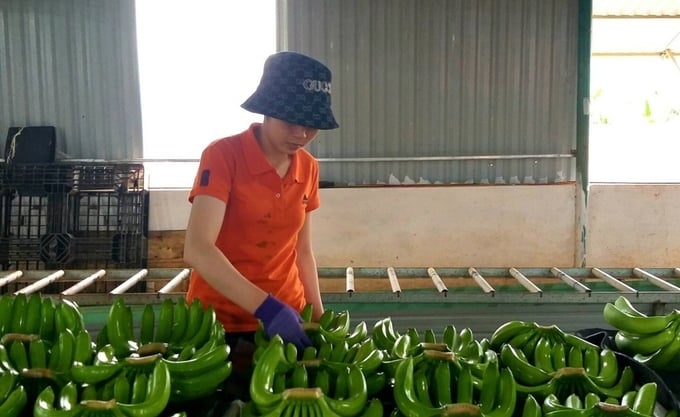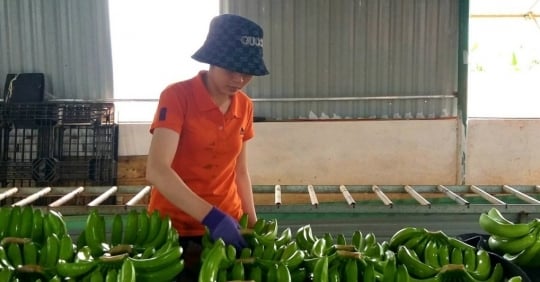(VAN) In the first four months of the year, Vietnam surpassed the Philippines to become the leading country exporting bananas to China, with a volume of nearly 355,000 tons.

Bananas are processed to be packed for export. Photo: Thi Ha.
The General Administration of Customs of China (GACC) has just announced the data. Accordingly, in the first four months of the year, Vietnam’s banana export output was 2.4 times higher than the Philippines.
Vietnamese bananas surpassed the Philippines for the first time, ranking second in a banana-growing area worldwide, after Ecuador. With an export output of 355,000 tons, Vietnam accounts for 48.6% of the total banana output imported into China.
Optimistic information about Vietnamese bananas in the Chinese market has been forecast from the end of April 2024. Most notably, China moved to increase banana imports from the Vietnamese market but decreased imports from the Philippines. The Philippines’ low production output has fueled a general cost rise, creating a significant price gap with Vietnamese bananas.
Moreover, according to the information from the Agency of Foreign Trade (MOIT), Philippine bananas were highly appreciated due to their flavor in the past. However, the fruit’s quality needs to meet consumers’ expectations.
Chinese customers are increasingly keen on Vietnamese and Cambodian bananas.
However, banana export prices from 10 countries to China simultaneously dropped sharply by 2-39%. Vietnamese goods decreased by 16% over the same period last year, down to USD 407.7 per ton.
Vietnam’s banana export value in 4 months only reached USD 145 million, up 3% over the same period in 2023, while output increased by 22%.
Leaders of banana export businesses in Dong Nai said prices have decreased because China has diversified its supply sources. In addition to importing from Vietnam and the Philippines, this country also imports from many different markets.
According to him, Vietnamese bananas dominate because they have more advantages than every year. Banana production in the Philippines – the country that has had the leading market share in China for decades – has declined due to the effects of climate change. In addition, the quality of Philippine bananas has also gone down.
Mr. Dang Phuc Nguyen, General Secretary of the Vietnam Fruit and Vegetable Association, said that the quality of Philippine bananas has decreased this year because many growing areas are infected with leaf rot disease. Logistics costs from this country to China also increased, making the price of their goods 33% higher than Vietnamese goods. Therefore, China increased its purchases of Vietnamese goods.
In the Chinese market, Vietnam competes well with the Philippines and the leading suppliers in Southeast Asia, such as Cambodia, Laos, and Thailand. In particular, the skyrocketing price of bananas from Thailand is making China no longer interested in goods imported from this country.
Particularly, Ecuador – the country with the largest banana area in the world – is penetrating the Chinese market with large output. However, this country is also limited when logistics costs increase, causing product prices to be sky-high.
In addition to China, Vietnamese bananas are exported vigorously to Malaysia, Singapore, Korea, Japan, and Qatar, with the quantity increasing rapidly each year.
According to the Agency of Foreign Trade (MOIT), in the first five months of this year, the export value of fruits and vegetables is estimated to reach nearly USD 2.6 billion, an increase of more than 28% over the same period in 2023.
Bananas are a product with a high export proportion, the third largest exporter in the fruit and vegetable group after durian and dragon fruit. In 2022, Vietnam signed a protocol to export bananas to China. This significant step has helped the banana industry transform dramatically and create more prestige in this market.
In 2023, banana exports will win big because the Chinese market will increase imports of this product through official channels. Banana farmers have promptly met the export standards. The export price of bananas in 2023 is up to VND 13,000 – 14,000 per kg; many gardeners win big, with profits up to VND 300-400 million per hectare.
Although bananas have been officially exported, the majority go to the Chinese market, while other markets export very little. Exporting bananas is highly dependent on the Chinese market, which will pose a high risk because as long as the Chinese market reduces imports, Vietnamese bananas will fall into a situation where the product cannot be sold, prices drop sharply, and farmers suffer heavy losses.
To escape the above situation, Mr. Nguyen said that localities need to plan appropriate banana growing areas and advise people not to increase the area massively. “For a long time, many farmers have chased after trees that have a high value on the market without carefully studying the output, so they often fall into risks,” Mr. Nguyen said.
In addition, according to Mr. Nguyen, businesses and authorities need to support trade promotion to open more export markets for bananas and other fruits. The risks will be reduced because another market will replace it when this market declines. At the same time, it is necessary to attract businesses to invest in processing fresh fruits to increase the value of the products and not worry about the fruit being produced being unsold.
Agriculture News | Agri Products Price



